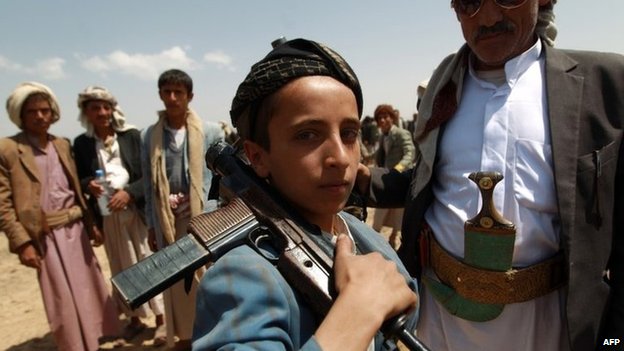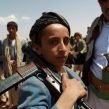
From Obscurity to Dominance: The Continuing Rise of Yemen’s al-Houthi Movement
Publication: Terrorism Monitor Volume: 12 Issue: 23
By:

During the last three years, the Houthi movement has accomplished a remarkable transformation, evolving from an obscure family-led Zaydi Shi’a guerrilla movement in Sa’ada governorate, one of Yemen’s most remote and underdeveloped, to become the country’s dominant military and political force. During the last six months in particular, the Houthi movement’s military wing, Ansar Allah, has seized control of the capital Sana’a and expanded into most of the country’s cultivated, upland region, while foraying even Aden in the south, Mareb in the east and Hodeidah in the west. Meanwhile in Sana’a, the Houthi leadership have displaced the formerly preeminent Sunni al-Ahmar family as country’s leading power brokers. Although predicting the future in a country as volatile as Yemen is arguably best left to the country’s numerous mystics and fortune tellers, this article will attempt to trace the Houthi movement’s remarkable recent trajectory, summarize its recent actions and briefly examine some likely future developments.
Clashes
Although the Houthis’ recent expansion throughout much of the Yemeni highlands passed off relatively peacefully, in recent weeks a spate of low-level clashes have illustrated that the Houthis face a number of challenges as they seek to consolidate their territorial and political gains, particularly from elite groups that have been displaced by the movement.
In Sana’a, Houthis have clashed repeatedly with a range of rivals. On November 26, clashes broke out between Houthis and supporters of the al-Ahmar family in the city’s Hasaba area, after an al-Ahmar vehicle refused to stop at a Houthi checkpoint and its occupants instead opened fire. The resulting violence, involving the use of heavy machine guns and RPGs, killed five and left the Houthis occupying the house of Sam al-Ahmar, a leading member of the dynasty (Yemen Times, November 26). Separate clashes have pitted Houthis against Salafists. On November 5, Houthi militants killed one French-Moroccan Salafist student in Sana’a, in an apparently unprovoked attack, and separately stormed the Sunna mosque, the city’s largest Salafist mosque, allegedly looking for weapons (Yemen Times, November 6). Many of the mosque’s students had reportedly previously studied in madrassas in Dammaj in Sa’ada governorate, the scene of numerous clashes between Houthis and Salafists in the past (Yemen Times, November 6). Further clashes took place in mid-November between the Houthis and security staff at the Sana’a airport when the Houthis attempted to assert control over the facility, including forcing the airport to employ 20 Houthis (al-Arabiya, November 11; Yemen Times, November 18).
Similar violence has occurred elsewhere. In Dhamar city, fighters from the local Bayt Hanash tribe attacked the Houthis after the latter ordered local merchants of qat (a popular narcotic shrub) to stop paying “taxes” to the tribe (Yemen Times, November 25). In Hodeidah meanwhile, on November 10, Houthis reportedly kidnapped Abdulrahman Mokarram, the leader of the Tihami movement, which represents the people of the Tihama coastal plain (al-Jazeera, November 10). This followed protests by Tihama activists against the Houthis, following the latter’s capture of the coastal city in October (Yemen Times, October 19). As these various incidents indicate, such clashes are typically the result of Houthis using their newfound power to settle old scores, displaced local elites reasserting their influence against the Houthis or else are a result of the group trying to neutralize potential sources of dissent. As such, such incidents are likely to continue both in Sana’a and across the country.
Meanwhile, the Houthis have also been in periodic conflict with fighters from al-Qaeda in the Arabian Peninsula (AQAP). Some of the most significant recent clashes have taken place in Rada’a, southeast of Dhamar, in a predominantly Sunni and traditionally lawless area on the edge of the desert. Heavy clashes here in early and mid-November killed over 85, in violence involving the use of tanks and artillery (al-Arabiya, November 14). AQAP social media accounts claimed their fighters had helped local tribesmen attack the Houthis; the accusation is credible given the strong Sunni feeling among local tribes and given that AQAP has previously operated in the area (Yemen Times, November 24). Previous apparently coordinated attacks between tribes and AQAP have occurred in other strongly-Sunni areas; for instance, in late September, an AQAP suicide bomber attacked Houthi forces in Mareb, killing around 15 Houthis (Yemen Times, September 30). AQAP also claimed credit for attacks on the Houthis in Hodeidah in November (al-Masdar, November 2)
From an overall national political perspective, however, the most significant rivalry is arguably between the Houthis and al-Islah, the Muslim Brotherhood’s Yemeni branch, which is closely linked with the al-Ahmar family. Houthis and al-Islah activists have clashed repeatedly during the last few years, most recently in Ibb in early November when a leading al-Islah politician was assassinated, and their rivalry is given an added bitterness by al-Islah’s former role as a key cheerleader of the army’s assaults on the Houthis’ during Ali Abdullah Saleh’s presidency (Yemen Times, November 4). While it is generally unhelpful to view the Houthi conflict through a “Sunni vs Shi’a” prism, the Houthis’ struggles with al-Islah, which contains both broadly non-sectarian traditional tribal figures and hardline Salafist elements, often fits this category. On November 29, however, it was reported that al-Islah and the Houthi group had reached a ceasefire agreement, brokered by Jamal Benomar, the UN Envoy to Yemen and the Gulf Cooperation Council (GCC) (al-Sharq al-Awsat, November 29). The agreement, pointedly negotiated on the Houthis’ home turf in Sa’ada, reportedly included agreements to end fighting, release prisoners and return seized property and included a commitment to maintain open communications. In practice, however, al-Islah is likely to regard any deal with the Houthis solely as a temporary expediency; al-Islah’s tribal figures will ultimately wish to regain their lost political influence and its ideologically-driven Salafist and Muslim Brotherhood elements will continue to resent living under the Houthis’ perceived Shi’a rule. [1] Meanwhile, for the Houthis, the ceasefire deal can be seen as a sign that the group is attempting to resolve some past feuds, perhaps driven by a recognition that the group faces numerous challenges and cannot afford an open-ended conflict with al-Islah.
The Houthi Political Agenda
Any attempt to understand the Houthi movement is invariably hampered by the group’s chronic inability to consistently or coherently articulate its goals. Beginning as a local Zaydi Shi’a family-based religious revivalist movement focused on protesting against heavy handed Sunni-flavored government intervention in Sa’ada, from the beginning it quixotically adopted “Death to America! Death to Israel!” as its universal slogan, despite this having no connection to its actual grievances or goals. Since capturing Sana’a in September, the movement has tried to present itself to Yemenis as a broad non-sectarian
“revolutionary” alternative to the discredited status quo and to the international community as a rational and credible partner. Saleh al-Sammad, a senior Houthi recently appointed as a political advisor to the president, personified these contradictions in a recent interview, describing first a sinister “American project… to occupy Yemen,” and then claiming that after the group’s capture of Sana’a, “the Ansar Allah displayed the highest degrees of tolerance. They did not attack the institutions of the state that were part of the six wars against the Ansar Allah. Nor did they attack their political adversaries, whether political parties or others” (al-Ahram, November 19). The group’s other spokesmen, such as Ali Emed of the group’s political office, have also repeatedly said that the group only aspires to create a non-sectarian “democratic civil state that guarantees the rights of everyone and is governed by the law” (Middle East Eye, September 1). The group has also repeatedly publicly renounced any ambitions to recreate the imamate, which the Saleh-era government often accused them of harboring.
Despite undertaking some steps to present itself as a regular, even mainstream, non-sectarian political party, the Houthi movement has nonetheless worked quickly to consolidate its power and embed itself in the country’s key institutions. For instance, the Houthis appear to have succeeded in their demand for some of their forces to be merged into the national army. On November 24, Yemen’s Defense Minister, Mahmoud al-Subaihi, said that this would be done as laid out in the Peace and National Partnership Agreement signed on September 21 between the Houthis and the government. However, he did not say how many Houthi fighters would be integrated or into which units, and he also stressed that “the military and security institution will remain in charge of all military and security forces” (Yemen Times, November 25). The Houthis’ likely aim is to consolidate their political influence, prevent the Yemeni Army from being used against the Houthis and ensure that some of the costs of maintaining the Houthi militia is, in the future, met by the state. In addition, the group has inserted its “advisors” into key government departments, with Saleh al-Sammad, for instance, becoming an advisor to the president, presumably with some sort of veto power over government decisions. Although the level of Iranian influence over the Houthi movement remains unclear, this strategy is strongly reminiscent of Hezbollah’s “state within a state” strategy in Lebanon and would give the Houthis considerable influence from behind the scenes.
Outlook
Although the Houthi movement has sought to increase its control over the Yemeni government without taking direct responsibility for running the Yemeni state, it is unclear whether it will be able to achieve this balance. Indeed, the Houthis have inherited the same challenges which led Ali Abdullah Saleh to describe governing Yemen as “dancing on the heads of snakes,” including a bankrupt and dysfunctional state, a fractious tribal environment, a smoldering al-Qaeda insurgency, an active southern separatist movement and regional powers willing to intervene to promote their own interests. Although the Houthi movement can potentially distance itself from some of the government’s failings, it is almost inevitable that any further collapse of law and order, the economy or government services will provoke discontent with the group.
It is also all but inevitable that Sunni forces and traditional tribal leaders, although knocked off-balance by the Houthis’ unexpected successes, will gradually reorganize themselves, seek out foreign funding and plan a comeback, regardless of the consequences for the country at large. In particular, al-Islah’s leaders are liable to try to seek Wahhabi or Gulf State funding and to meanwhile stoke domestic anti-Shi’a sectarian feeling for their own political gain. For instance, Tawakkol Karman, a leading al-Islah member (and Nobel Peace Prize winner) recently described the Houthis as being “supported financially and militarily by Iran” in order to “undermine the Yemeni republic” as part of “an Iranian project that is targeting the entire region” (Arabi21.com, September 29). Meanwhile, the General People’s Congress, the former ruling party, although seemingly operating in conjunction with the Houthis at present, may at some point seek to regain its old monopoly on power. Much also depends on what the Houthis themselves do next. At times, the movement seems content to accept its role as one party of many in the government and to focus on attaining formal federalism for its heartlands in northern Yemen. At other times, however, as demonstrated by its recent attempts to reposition itself as a national “revolutionary” movement, or to integrate its fighters into the army, or by its forays to Hodeidah, Mareb and Aden – all far outside the traditional Zaydi or Houthi heartlands – it seems to have grander aspirations. Regardless, the deeper causes of Yemen’s malaise are ultimately economic and given the country’s catastrophic financial situation, compounded by falling oil revenues, a growing water shortage and a booming population, the country is bound to remain unstable for many years to come, regardless of the political machinations of the Houthis, al-Islah and other groups.
James Brandon is a political and security risk analyst.
Note
1. See for instance, “Interview: Muhammad Qahtan, senior member of Yemen’s al-Islah,” al-Ahram, November 27, 2014, https://english.ahram.org.eg/NewsContent/2/8/116588/World/Region/Interview-Mohammed-Qahtan,-senior-member-of-Yemens.aspx.





